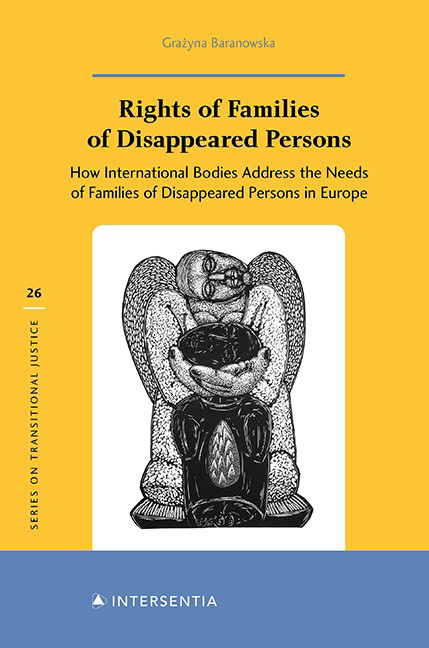Book contents
- Frontmatter
- Acknowledgements
- Contents
- List of Cases
- Chapter 1 Introduction to the Rights and Needs of Families of Disappeared Persons
- Chapter 2 The European Court of Human Rights and Disappeared Persons: Broadening in Substantiating Claims and Narrowing Down Through Application of Temporal Competences
- Chapter 3 The UN Human Rights Committee and Disappeared Persons: Approaches to the Right to Life
- Chapter 4 International Judicial Bodies Established in Response to Conflicts in the Former Yugoslavia: Addressing Mass Disappearances
- Chapter 5 Searching For and Exhuming Disappeared Persons: International Non-Judicial Mechanisms
- Chapter 6 Conclusion: Addressing Rights and Needs of Families of Disappeared Person in Europe
- Index
Chapter 2 - The European Court of Human Rights and Disappeared Persons: Broadening in Substantiating Claims and Narrowing Down Through Application of Temporal Competences
Published online by Cambridge University Press: 10 December 2021
- Frontmatter
- Acknowledgements
- Contents
- List of Cases
- Chapter 1 Introduction to the Rights and Needs of Families of Disappeared Persons
- Chapter 2 The European Court of Human Rights and Disappeared Persons: Broadening in Substantiating Claims and Narrowing Down Through Application of Temporal Competences
- Chapter 3 The UN Human Rights Committee and Disappeared Persons: Approaches to the Right to Life
- Chapter 4 International Judicial Bodies Established in Response to Conflicts in the Former Yugoslavia: Addressing Mass Disappearances
- Chapter 5 Searching For and Exhuming Disappeared Persons: International Non-Judicial Mechanisms
- Chapter 6 Conclusion: Addressing Rights and Needs of Families of Disappeared Person in Europe
- Index
Summary
PRELIMINARY REMARKS CONCERNING THE ANALYSIS OF ECtHR JUDGMENTS
THE CONCEPTUAL FRAMEWORK OF THE ANALYSIS
The European Court of Human Rights (ECtHR) issued its first judgment in an enforced disappearances case in 1998 and developed its early jurisprudence relating to the phenomenon by reviewing applications against Turkey. Subsequently the Court received applications relating to this phenomenon from Bosnia and Herzegovina, Croatia, Cyprus, Italy, Poland, Spain, and Russia. Judgments against Russia currently constitute the largest part of the ECtHR's jurisprudence on the subject. The Court has issued over 200 rulings to date on individual applications concerning enforced disappearances, and one on an intergovernmental complaint filed by Cyprus against Turkey.
Analysis of the jurisprudence is focused first and foremost on matters that serve to examine how the Court addresses the identified fundamental needs of families of disappeared persons: returning the remains of the disappeared person; the right to the truth; the acceptance of responsibility by the states; and the right to compensation. This analysis is divided into four parts: the first two (temporal issues and substantiating claims) are essential to making a case in the ECtHR, while the third and fourth parts (recognising families as victims and reparation measures) concern the families of the disappeared persons and their identified needs. Analysis of the above makes it possible to assess the effectiveness of the ECtHR's judgments and decisions in terms of their meeting the four identified basic needs of the families of disappeared persons.
The first questions analysed are temporal issues (section 2). They are of key importance, as many enforced disappearances in Europe occurred before the European Convention on Human Rights (ECHR) entered into effect in the respective states. Additionally, many of the families of disappeared persons applied to the ECtHR years after the disappearances occurred. Two issues are relevant with respect to the temporal issues of applications concerning enforced disappearances. The first is the necessity of adhering to the six-month time limitation, i.e. the provision that ‘the Court may only deal with the matter … within a period of six months from the date on which the final decision was taken’ (Article 35.1).
- Type
- Chapter
- Information
- Rights of Families of Disappeared Persons , pp. 37 - 110Publisher: IntersentiaPrint publication year: 2021



